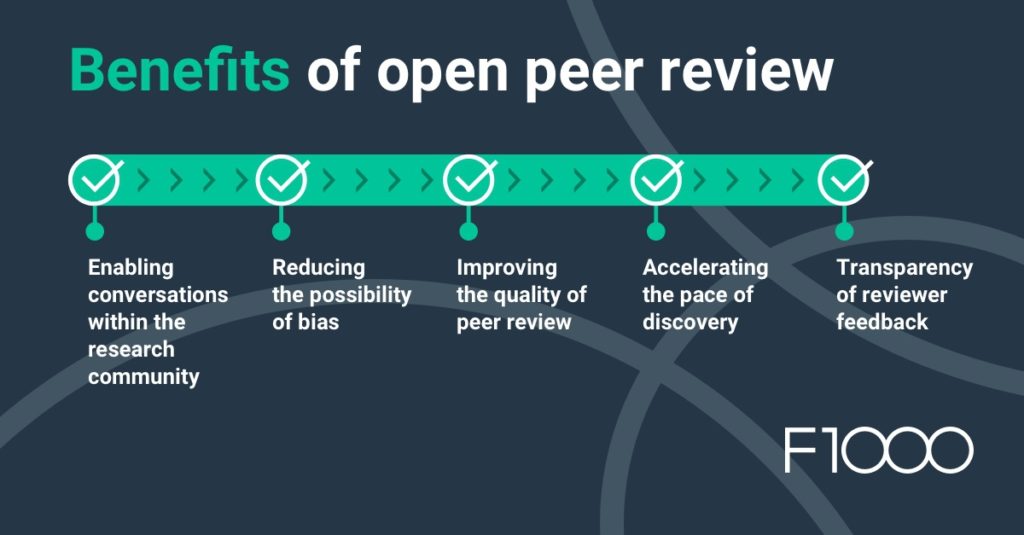
Open peer review: establishing quality
Peer reviewers play a crucial role in scholarly publishing. The tradition of peer review is long-standing due to the importance of validating and improving academic work. F1000’s innovative model puts transparency center-stage, by publishing the full names and affiliations of reviewers, so that peer review becomes a constructive, collaborative conversation within the research community. Transparency in the peer review process is now being understood to be a hallmark for quality and accountability, making it easier to know if research can be trusted.
Enable conversations in the open peer review space
At F1000, peer review takes place after the article has been published openly on the platform, so research can start being read and used while expert reviewers assess it. This transparency of author and reviewer comments enables a two-way conversation within the research community. F1000’s open peer review model demonstrates to readers how and why decisions were made in relation to peer review:
Visibility of any conflicts of interest and competing interest: F1000 asks that invited reviewers contact the team first with any potential COI (conflicts of interest) before agreeing to review an article and provide some examples. Then we can determine if they are still a suitable, unbiased, reviewer on a case-by-case basis. If it is agreed that a reviewer can still go ahead, the reviewer has to declare and give details of this COI, which is then published with their report. If a reviewer does not declare any COIs, the line ‘No competing interests were disclosed’ is added to their report.
Author responses are published: There is full visibility of how and why authors address peer reviewer feedback, I.e., authors update their research to reflect any learnings from the peer review comments. Newer versions of their work can be viewed openly, alongside older versions for reflection. Authors are encouraged to reply to each reviewer separately to truly engage in this collaborative process.
Geographically diverse reviewers: Global perspectives are important at F1000 and enabling this transparency in peer review allows diversification of content. Widening the pool of reviewers increases expert feedback compared to what has been previously available.
Readers can comment during peer review: Anyone reading an article can also provide useful feedback or ask questions about the article. This third communication channel champions collaboration and quality in the peer review process.
Transparency in data: Through employing open data mandates the F1000 peer review process encourages quality in peer review. Data that is published can be accessed by everyone, illustrating how a conclusion has been achieved. There are some exceptions with regards to sensitive data.

Reducing the possibility of bias
The editorial team at F1000 perform numerous editorial checks for any conflict of interests and collaboration during the peer review process. The standard peer reviewer criteria for F1000 ensures all peer reviewers are qualified, experts in the subject-area, impartial and global for breadth of perspective. The strength of our peer review model lies in a fully open process, which means there is transparency of any possible bias.
Potential competing interests are declared and visible to all readers. Our editorial team can recognize if a professional hasn’t been appropriate, both in terms of expertise and potential competing interests. This reflective process means accountability is taken for all published material, e.g., conflicts of interest can be added alongside an article retrospectively if a reader lets us know. The F1000 editorial team also assess reviewer criteria on a case-by-case basis; we understand not all topics are the same and need varied editorial checks dependent on the subject area. This applies to niche and small fields of interest.
Impartial peer review checks
When determining whether reviewers are impartial, F1000 assesses whether reviewers have collaborated with any of the authors on an article. Reviewers based at the same institution as the authors and those who have co-authored a paper with any of the authors aren’t accepted. There are some exceptions to this, which is part of our ‘case-by-case’ assessment for small/highly collaborative fields. Examples of close collaborations come under our definition of competing interests that could bias a reviewer’s assessment of an article.
Improving the quality of peer review
Trials have shown that open reports tend to be more constructive, resulting in impactful research. Being open and transparent gives readers insight into the process, with visibility of expert opinions, and possible limitations of a study. Increasing the number of peer reviewers and encouraging diversity leads to a thorough peer review process. We currently aim for two peer review reports per article version.
Transparency in the peer review process adds the onus of accountability by making peer reviewer names public, along with their reviews. Expertise is ensured through this process as readers can recognize if a reviewer is qualified to give their feedback on a specific topic. Peer reviewers can also add details around their research areas, which is published with their report. The F1000 editorial team performs checks of peer review reports to guarantee all reports uphold a certain quality and are aligned with our reviewer code of conduct. Authors will also be aware of who is reviewing their articles; building the author’s trust in the feedback they’ve received as they can now confirm the reviewer’s expertise.
Access to knowledge
Everyone benefits and learns from reading reviewer feedback. The transparency in open peer review instils trust in the process and engages society through enabling access to knowledge.
Authors can have an open discussion around their article and research with reviewers, allowing them to explore further and providing an opportunity to explain their choices. There is additional feedback from comments in response to their explanations, leading to a thorough definitive version.
Peer reviewers fully immersed in the process will gain recognition for their participation in the peer review and co-reviewing process. This is especially beneficial for early career researchers who learn how to review and gain recognition for their contribution.
Readers are another core part of the model as transparency of conversations and versioning allows them to learn how to review through reading reports. They are gaining a better understanding of how articles arrive at the stage of being updated.
Fostering an open peer review model with transparency at the core of the model is increasing in academic publishing and F1000 is proud to be at the forefront. We are establishing that open peer review needs to come with methodical standards for quality to reduce the possibility of bias in the peer review process.
Thank you to our F1000 editorial team for their guidance and expertise. Kate McRobbie, Senior Editorial Assistant and Jeniffer Jeyakumar, F1000 Peer Review Coordinator, have both been instrumental in guiding this article.
For further information on our peer review model, view these resources:
Reviewer guidelines – includes code of conduct for all F1000 peer reviewers
Information and resources for peer reviewers on F1000Research
Learn more about what we can do for you at F1000.
